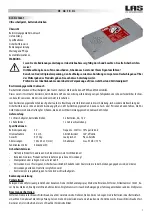
Page 2 of 2
7. In order to prevent the Remote Receiver (fireplace installation only) from overheating, put a heat
shield
(option item) above the Remote Receiver. See
Figure 5
.
2.0 IMPORTANT SAFETY FEATURE:
You can set a private code into your system to prevent accidental operation by another transmitter
nearby. See
Figure 6
.
2.1 Coding Instructions:
1. Remove the cover on the back of the Remote Transmitter to expose the code switches. Slide the code
switches to your choice of ON or OFF positions. FACTORY SETTING IS ALL "OFF".
2. Make sure the slide switch on the Remote Receiver is at OFF position.
3. Keep the Remote Transmitter and the Remote Receiver within 2-10 feet.
4. Slide the slide switch on the Remote Receiver to REMOTE position.
5. Install fresh AAA alkaline batteries into the Remote Transmitter.
6. Press any button on the Remote Transmitter, the Remote Receiver will produce a 'beep' sound when it
receives the code from the Remote Transmitter.
7. If you do not hear a 'beep' sound from the Remote Receiver, remove the batteries from the Remote Transmitter
and slide the slide switch on the remote receiver to OFF position, Wait for 1 minute, and repeat step 2 to 6.
8. Replace the cover of the Remote Transmitter and the Receiver. The system is now ready to operate.
FCC Requirements
Warning : Changes or modifications to this unit not expressly approved by the party responsible for compliance could void the user authority
to operate the equipment. This equipment has been tested and found to comply with the limits for a Class B digital device, pursuant to
Part 15 to the FCC Rules. These limits are designed to provide reasonable protection against harmful interference in a residential installation.
This equipment generates, uses, and can radiate radio frequency energy and, if not installed and used in accordance with the instructions,
may cause harmful interference to radio communications. However, there is no guarantee that interference will not occur in a particular
installation. If this equipment does cause harmful interference to radio or television reception, which can be determined by turning the
equipment off and on, the user is encouraged to try to correct the interference by one or more of the following measures:
-
Reorient or relocate the receiver antenna.
-
Increase the separation between the equipment and receiver.
-
Connect the equipment into an outlet on a circuit different from that to which the receiver is connected.
-
Consult the dealer or an experienced radio TV technician for help.
Canadian Equipment Requirements
This digital apparatus does not exceed the (class A/Class B)* limits for radio noise emissions from digital apparatus set out in the Radio
Interference Regulations of the Canadian Department of Communications. Le present appareil numerique n'emet pas de bruits radioelectriques
depassant les limites applicables aux appareils numeriques (de la class A/de la class B)* prescrites dans le Reglement sur le brouillage
radioelectrique edicte par le ministere des Communications du Canada.
This device complies with RSS-210 of Industry and Science Canada. Operation is subject to the following two conditions: (1) this device
may not cause interference, and (2) this device must accept any interference, including interference that may cause undesired operation
of the device.
All wiring should be done by a qualified electrician and shall be in compliance with local codes and with the National Electirc Code ANSI/NFPA
No. 70-current (In the United States), or with the current CSA C22.1 Canadian Electirc Code (in Canada).
Figure 4
FIREPLACE REMOTE
PRESS
TO OPEN
OFF
ON
REMOTE
BAT.LOW
PRESS
TO OPEN
BAT.LOW
OFF
REMOTE
ON
Re m o t e
Re ce ive r
In su l a to r
Figure 5
Heat-Shield
Child-Proof
Switch
Code
Switches
Figure 6
P/N:81-080005-00
This device complies with Part 15 of the FCC Rules.
Operation is subject to the following two conditions:
(1) This device may not cause harmful interference, and
(2) This device must accept any interference received, including interference that may cause undesired operation.
























